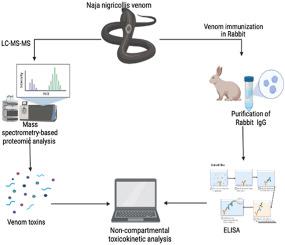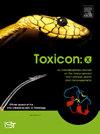Snakebite envenoming (SBE) is a neglected public health problem, especially in Asia, Latin America and Africa. There is inadequate knowledge of venom toxicokinetics especially from African snakes. To mimic a likely scenario of a snakebite envenoming, we used an enzyme-linked immunosorbent assay (ELISA) approach to study the toxicokinetic parameters in rabbits, following a single intramuscular (IM) administration of Northern Nigeria Naja nigricollis venom. We used a developed and validated non-compartmental approach in the R package PK to determine the toxicokinetic parameters of the venom and subsequently used pharmacometrics modelling to predict the movement of the toxin within biological systems. We found that N. nigricollis venom contained sixteen venom protein families following a mass spectrometric analysis of the whole venom. Most of these proteins belong to the three-finger toxins family (3FTx) and venom phospholipase A2 (PLA2) with molecular weight ranging from 3 to 16 kDa. Other venom protein families were in small proportions with higher molecular weights. The N. nigricollis venom was rapidly absorbed at 0.5 h, increased after 1 h and continued to decrease until the 16th hour (Tmax), where maximum concentration (Cmax) was observed. This was followed by a decrease in concentration at the 32nd hour. The venom of N. nigricollis was found to have high volume of distribution (1250 ± 245 mL) and low clearance (29.0 ± 2.5 mL/h) with an elimination half-life of 29 h. The area under the curve (AUC) showed that the venom remaining in the plasma over 32 h was 0.0392 ± 0.0025 mg h.L−1, and the mean residence time was 43.17 ± 8.04 h. The pharmacometrics simulation suggests that the venom toxins were instantly and rapidly absorbed into the extravascular compartment and slowly moved into the central compartment. Our study demonstrates that Nigerian N. nigricollis venom contains low molecular weight toxins that are well absorbed into the blood and deep tissues. The venom could be detected in rabbit blood 48 h after intramuscular envenoming.



